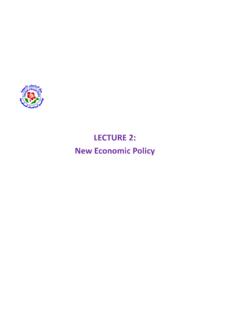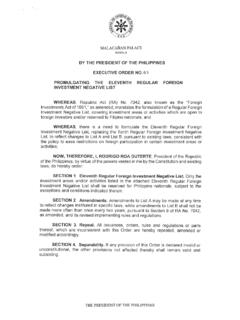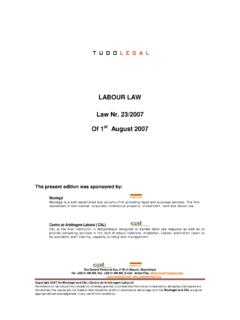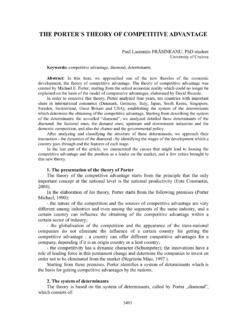Transcription of Question Bank - Multiple Choice Questions (MCQs) - DACC
1 DNYANSAGAR ARTS AND COMMERCE COLLEGE, BALEWADI, PUNE 45 Subject: Business Economics (Macro)-305 CLASS: SYBBA III SEM (2013 PATTERN) PROF. Heena D. Gandhi Question Bank - Multiple Choice Questions (MCQs) Unit: 1 Basic concepts of Macro economics 1) Who is credited with bringing the term "the invisible hand" in economics? a) Adam Smith b) John Maynard Keynes c) F. Hayek d) Samuelson 2) Macroeconomics as a separate branch came to be studied after the contributions of which economist? a) Adam Smith b) John Maynard Keynes c) F. Hayek d) Samuelson 3) When did the Great Depression hit the United States? a) 2007 b) 1929 c) 1936 d) 2001 4) Consider the following statements: 1.
2 In a Capitalist economy there is private ownership of means of production 2. In a communist nation, the means of production are owned by the State 3. In a free-market economy there is minimum role of the Government Which of the above 3 statement is/are true? a) Only 1 and 3 b) Only 2 and 3 c) Only 3 d) All are true 5) Macroeconomics is a study of economics that deals with which 4 major factors: a) households, firms, government, and demand-supply b) households, firms, government and external sector c) firms, government, free-market, and regulations d) none of the above DNYANSAGAR ARTS AND COMMERCE COLLEGE, BALEWADI, PUNE 45 Subject: Business Economics (Macro)-305 CLASS: SYBBA III SEM (2013 PATTERN) PROF. Heena D. Gandhi 6) What are consumption goods?
3 A) Goods used for consumption in the production process b) Goods such as tools, machinery, etc which are used to create final consumption goods c) Goods and services that are consumed fully when purchased by the consumers d) None of the above 7) What are Capital goods? a) Goods used for consumption in the production process b) Goods such as tools, machinery, etc which are used to create final consumer goods c) Goods and services that are consumed fully when purchased by the consumers d) None of the above 8) Intermediate goods are not included to calculate the final output because: a) they do not have value b) they have unknown value c) their value is included in final goods so they are not added to avoid the problem of double counting d) none of the above 9) What does the term Gross investment mean while denoting a nation's economy?
4 A) Gross investment= Net investment + Depreciation b) Gross investment= Net investment - Depreciation c) Gross investment= Depreciation - Net investment d) None of the above 10) What does the term free-market denote in terms of economy? a) Minimal government intervention in trade and minimum regulations b) Maximum government intervention in trade and maximum regulations c) Means of production owned by the state d) None of the above 11) _____economics can study the problem of Inflation in the country. a) Micro b) Macro c) Static d) Dynamic DNYANSAGAR ARTS AND COMMERCE COLLEGE, BALEWADI, PUNE 45 Subject: Business Economics (Macro)-305 CLASS: SYBBA III SEM (2013 PATTERN) PROF. Heena D. Gandhi 12) The credit of development of macroeconomic approach must go to _____.
5 A) Dr. Marshall b) Prof. Pigou c) Lord Keynes d) Mrs. Joan Robinson) 13) Macroeconomics does not study _____. a) whole economy b) national income c) aggregate supply d) product pricing) 14) _____ is the subject matter of Macroeconomics. a) Growth theory b) Factory Pricing c) Market Structure d) Individual Incomes 15) Micro and Macro approaches are _____. a) Competitive b) Alternative c) Substitutes d) Complementary State the following statements are true or false: 16) Increase in national income is a Micro- Economic goal. True / False 17) Macro-Economic adopts lumping method. True / False 18) Study of price determination is a subject matter of Macro-Economics. True / False 19) Micro-Economics deals with the study of aggregates. True / False DNYANSAGAR ARTS AND COMMERCE COLLEGE, BALEWADI, PUNE 45 Subject: Business Economics (Macro)-305 CLASS: SYBBA III SEM (2013 PATTERN) PROF.
6 Heena D. Gandhi 20) For economists, statements about the world are of two types: a) Assumptions and theories b) Positive statements and negative statements c) Positive statements and normative statements d) Specific statements and general statements 21) The opportunity cost of going to university is: a) The total spent on food, clothing, books, transportation, tuition, lodging and other expenses b) Zero for students who are fortunate enough to have all of their university expenses paid by someone else c) Zero, since a university education will allow a student to earn a higher income after graduation d) The value of the best opportunity a student gives up to attend university 22) In a market economy: a) Households decide which firms to work for and what to buy with their incomes b) Profit and self-interest guide the decisions of firms and households c) Firms decide whom to hire and what to produced.
7 D) All of the above are true 23) Statistics such as GDP, the unemployment rate, the rate of inflation and the trade balance are: a) Macro, since they tell us something about the entire economy b) Neither macro nor micro, but properly in the realm of political science c) Both micro and macro d) Micro, since they affect individual households and firms 24) What do you mean by a mixed economy? a) Modern and traditional industries b) Public and private sectors c) Foreign and domestic investments d) Commercial and subsistence farming 25) Capitalism refers to? a) The use of market b) Government ownership of capital c) Private ownership of capital goods DNYANSAGAR ARTS AND COMMERCE COLLEGE, BALEWADI, PUNE 45 Subject: Business Economics (Macro)-305 CLASS: SYBBA III SEM (2013 PATTERN) PROF. Heena D. Gandhi d) Private ownership of homes & cars 26) In Economics, a good is something which, a) Is a service b) Can be a service c) Appears appealing d) Satisfies wants and needs 27) The basic factors of production are land, labour, capital and, a) Enterprise b) Investment c) Machinery d) Resources 28) Macroeconomics became popular after------------- a) Great depression of 1929- 33 b) 1972-73 c) 1996- 97 d) 2006- 07 29) The term macro has been derived from-------------- a) Greek word makros which means large b) English word makros which means large c) Greek word makros which means small d)
8 French word makros which means large 30) In macroeconomics, we study about ------------------ a) Theory of National Income & Employment b) Theory of Money Supply & Price Level c) Theory of International Trade & Eco growth d) All of the above. 31) Which of the following is/are the goals of macroeconomics-----------? a) To Achieve Higher Level of GDP b) To Achieve Higher Level of Employment c) Stability of Prices d) all the above 32) The study of groups and broad aggregates of the economy is known as----------- a) Microeconomics b) Macroeconomics c) International Economics DNYANSAGAR ARTS AND COMMERCE COLLEGE, BALEWADI, PUNE 45 Subject: Business Economics (Macro)-305 CLASS: SYBBA III SEM (2013 PATTERN) PROF. Heena D. Gandhi d) None of the above.
9 State the following statements are true or false: 33) The term microeconomics and macroeconomics were first given by Ragner Frisch in 1933. True / False 34) Prof. Keynes is known as father of modern macroeconomics. True / False 35) Macroeconomics became popular after great depression of 1929- 33. True / False 36) Prof. J. M. Keynes wrote the book General Theory of Employment, Interest and Money in 1936. True / False 37) Price is the main determinant of macroeconomics. True / False 38) Income is the main determinant of microeconomics. True / False 39) Partial equilibrium analysis is used in microeconomics. True / False 40) General equilibrium analysis is applied in microeconomics. True / False 41) Keynesians believe in free- market economy. True / False 42) Microeconomics and macroeconomics are independent to each other.
10 True / False DNYANSAGAR ARTS AND COMMERCE COLLEGE, BALEWADI, PUNE 45 Subject: Business Economics (Macro)-305 CLASS: SYBBA III SEM (2013 PATTERN) PROF. Heena D. Gandhi Unit 1 Answer Keys 1-a 2-b 3-b 4-d 5-b 6-c 7-b 8-c 9-a 10-a 11-b 12-c 13-d 14-a 15-d 16-F 17-T 18-F 19-T 20-c 21-d 22-d 23-a 24-b 25-c 26-d 27-a 28-a 29-a 30-d 31-d 32-b 33-T 34-T 35-T 36-T 37-F 38-F 39-T 40-F 41-F 42-F Unit: 2 National Income accounting 1) The average income of a country is called a) Per capita income b) Disposable income c) Inflation rate d) Real national income 2) The value of NNP at production point is called a) NNP at factor cost b) NNP at market price c) GNP at market price d) GNP at factor cost 3) The value of NNP at consumer point is called the a) NNP at factor cost b) NNP at market price c) GNP at market price d) GNP at factor cost 4) When depreciation is deducted from GNP, the net value is a) Net national product (NNP) b) Net domestic product c) Gross national product d) Disposable income 5) Consider the following statements and identify the right ones.





